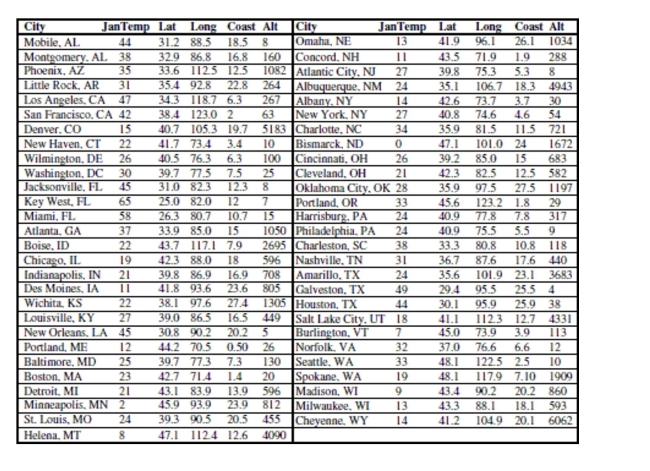Here are data about the average January low temperature in cities in the United States, and factors that might allow us to
predict temperature. The data, available for 55 cities, include:  We will attempt to make a regression model to help account for mean January temperature and to understand the effects of
We will attempt to make a regression model to help account for mean January temperature and to understand the effects of
the various predictors.
At each step of the analysis you may assume that things learned earlier in the process are known.
Units Note: The "degrees" of temperature, given here on the Fahrenheit scale, have only coincidental language relationship to
the "degrees" of longitude and latitude. The geographic "degrees" are based on modeling the Earth as a sphere and dividing it
up into 360 degrees for a full circle. Thus 180 degrees of longitude is halfway around the world from Greenwich, England
(0°) and Latitude increases from 0 degrees at the Equator to 90 degrees of (North) latitude at the North Pole. 
-Now, consider longitude. Should the longitude of a city have an influence on average
January low temperature? Here is the regression: Dependent variable is: JanTemp
R squared R squared (adjusted)
with degrees of freedom
Test the null hypothesis that the true coefficient of Long is zero in this regression. State the
null and alternative hypotheses and indicate your procedure and conclusion.
Correct Answer:
Verified
t-ratio is
View Answer
Unlock this answer now
Get Access to more Verified Answers free of charge
Q15: For a class project, students tested
Q17: Here are data about the average January
Q18: The regression below predicts the daily
Q18: Of the 23 first year male
Q19: The regression below predicts the daily
Q20: The regression below predicts the daily
Q21: A student wants to build a
Q22: Here are data about the average
Q24: Three brands of AAA batteries are
Q25: The regression below predicts the daily
Unlock this Answer For Free Now!
View this answer and more for free by performing one of the following actions

Scan the QR code to install the App and get 2 free unlocks

Unlock quizzes for free by uploading documents